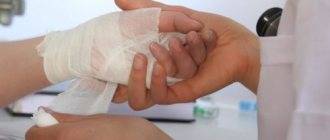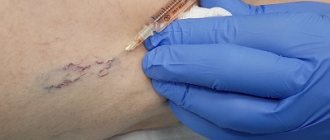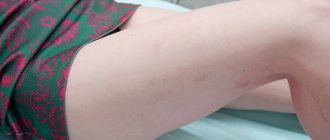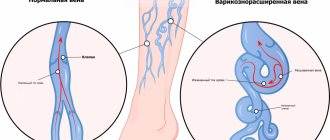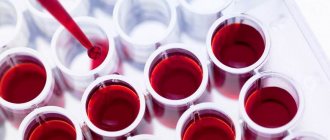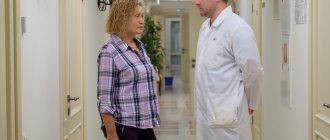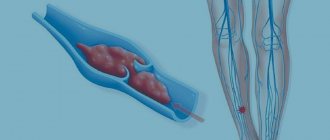Nowadays, it’s rare for anyone to boast of healthy blood vessels in their legs. At the end of the working day, the legs begin to ache tiredly, buzz and ache, veins treacherously bulge on the skin and more and more spider veins appear.
Spider veins (telangiectasia) are dilated intradermal capillaries that form a “star” on the skin. The appearance of spider veins is a signal that you need to strengthen your blood vessels. Unfortunately, this is not just a cosmetic defect, but a manifestation of the initial stage of varicose veins and a serious reason to consult a phlebologist and treat blood vessels in the legs.
Types of spider veins
Telangiectasia can be different in color (red and blue), shape (vascular formations in the form of a “tree”, “mesh”, “star”, “spider”), localization (formed both on the face and body).
Red linear telangiectasias most often form on the face (on the nose and cheeks).
On the legs there are red or blue linear and tree-shaped spider veins, which are formed due to the bursting of blood vessels in the legs. Spider telangiectasias are usually red in color and occur on the back or abdomen
In women with spider veins on the legs, vascular formations are most often located in groups (on the inner side of the thigh they are located parallel to each other and have a linear appearance, and on the outer side they are circumferential and have a “tree-like” shape).
Causes of the disease
Spider veins appear due to the fact that intradermal capillaries lose their tone. There are many reasons for this:
- Pregnancy, postpartum period (often “stars” appear due to hormonal imbalance and compression of the pelvic vessels);
- hormone therapy;
- varicose veins;
- hereditary predisposition;
- hypertension (high blood pressure dilates the capillaries);
- chronic liver diseases;
- excessive physical stress;
- abuse of the sun, solarium, sauna, bath;
- alcohol abuse;
- prolonged load on the legs in a vertical position, etc.
Bleeding from varicose veins
Poor circulation can lead to varicose veins with the formation of blood clots. If the disease is not treated, complications will invariably arise that can be life-threatening. Along with varicose veins, varicose veins are formed - bubbles that have an uneven shape. Deformation and thinning of the wall of varicose veins often lead to the development of bleeding from varicose veins at the slightest trauma to the vessels. Bleeding from varicose veins occurs daily in patients in European countries, Moscow and the Moscow region. Leading specialists of both public and private city phlebological centers weekly face the problem of bleeding from varicose veins. Innovative technologies can easily prevent bleeding from varicose veins, but even the most advanced medical innovations are sometimes unable to save a person’s life if precious time is lost.
Bleeding from varicose veins
Blood clot in the legs: the most common symptoms
15.10.2019
The formation of a blood clot in the deep veins of the lower extremities is a dangerous disease, as there is a risk of life-threatening complications. The thrombus can break away from the vascular wall, and the venous system reaches the heart and pulmonary artery - a pulmonary embolism occurs. When the pulmonary artery is completely blocked by a blood clot , sudden death occurs.
An increased risk deep vein thrombosis occurs in smokers, pregnant women, the elderly, patients with obesity , tumors, and blood .
What are the risk factors for developing a blood clot?
Factors contributing to the formation of a blood clot:
- dehydration;
- prolonged immobilization, such as air travel;
- presence of varicose veins ;
- pregnancy ; injuries, operations ;
- blood disorders ;
- medicines - contraceptives;
- obesity.
There are three main mechanisms for the formation of blood clots:
- damage to the wall of a blood vessel . If there is damage to the vascular wall (rupture, trauma, tingling), adrenaline, norepinephrine and serotonin are released, causing vasospasm . Platelets, and then white and red blood cells cling to the lesion - a blood clot ;
- venous sagging - delayed blood flow and congestion in large vessels favor thrombosis ;
- increased blood - Increased blood occurs during injuries, surgeries, tumors, burns, and dehydration.
What are the symptoms of a thrombus (blood clot) in the veins of the lower extremities?
At an early stage, when the blood clot is small and does not completely block the lumen of the affected vein , there is no inflammation and symptoms may be absent.
Here are some classic symptoms you may experience with a blood clot in your legs:
- spontaneous pain. In some cases there may be little pain, such as heaviness or discomfort, and in other cases there may be quite a lot of pain. In an upright position, the pain intensifies;
- painful pain in the course of large vessels ;
- pain in the groin of large vessels occurs in the area of the inguinal fold, in the buttock, inside the thigh;
- provoked pain. Pain occurs in the following cases: in the dorsiflexion of the foot pain is provoked, in the lower part of the leg - due to the release of the tibial veins ; coughing and sneezing cause pain in the corresponding limb;
- swelling. Painful swelling in the area of the clot - ankle, lower leg . It is typical for the swelling to not go away with cold compresses and may be enlarged for no apparent reason;
- change in skin color. The skin turns red and then turns blue-gray. The appearance of red spots on the skin in the area of the clot is a characteristic sign of the formation of a blood clot in the deep veins . These spots do not disappear over time, but become larger;
- warming of the skin. Increased skin temperature in the area of the blood clot is a relatively early sign. Warm skin may be accompanied by other symptoms such as itching, throbbing;
- dilated superficial veins - dilated veins around the ankle, lower leg, at the base of the thigh dilate;
- general symptoms are increased heart rate, fever, dizziness , anxiety.
Published in Phlebology Premium Clinic
Causes of bleeding from varicose veins
The leading cause of bleeding from a varicose vein is its rupture, which can occur due to several circumstances:
- Mechanical damage. In this way, you can provoke a rupture of both those varicose nodes that are located outside and visible to the eye, and those that are located deeper.
- Thinning of the wall of the varicose vein. Often a complication of varicose veins is thrombophlebitis - inflammation of the venous wall. It thins out and becomes fragile. Therefore, when, without treatment, a varicose node increases in size, its wall simply cannot withstand the load and bursts.
Of course, bleeding from varicose veins is a manifestation of an advanced stage of varicose veins; therefore, in order to avoid such complications, it is necessary to promptly contact a good European phlebologist in Moscow, who will prescribe appropriate modern treatment. And it is better to find a specialist who knows innovative methods of treating veins for the most effective treatment. Only modern technologies today meet state European standards.
Varicose veins, which may cause bleeding from the veins
Treatment of spider veins
Spider veins tend to progress: an increasing number of neighboring capillaries are involved in the process, and entire “networks” are formed. The easier it is to get rid of “stars”, the smaller the area they occupy.
Removal of spider veins is carried out using various conservative and surgical methods: sclerotherapy, ozone therapy, radio wave and laser methods.
1
Sclerotherapy in MedicCity
2 Sclerotherapy in MedicCity
3 Sclerotherapy in MedicCity
The radio wave method (Surgitron) is the removal of an enlarged capillary using a thin electrode without damaging surrounding tissues and healthy vessels. An ideal method for removing single spider veins on the face, which does not leave scars.
1 Laser removal of spider veins in MedicCity
2 Laser removal of spider veins in MedicCity
3 Laser removal of spider veins in MedicCity
Removal of spider veins with a laser (laser coagulation) is used in the presence of widespread vascular network. The laser beam is selectively absorbed by the pathological vessel forming the spider vein and heats it. At high temperatures, the walls of the vessel stick together, and the vessel is irreversibly damaged.
Sclerotherapy (introduction of a sclerosant into the lumen of the vessel, which causes adhesion of the vessel walls) is effective against fairly large telangiectasias, located mainly on the legs.
You can learn how sclerotherapy is performed from the video. The procedure takes place on an outpatient basis, before our eyes: thanks to a simple injection, the patient gets rid of spider veins on her leg.
Spider veins may appear again. To prevent relapse, it is necessary to take medications to strengthen blood vessels and use compression stockings.
1 Before and after removal of spider veins using sclerotherapy in MedicCity
2 Before and after removal of spider veins using sclerotherapy in MedicCity
3 Before and after removal of spider veins using sclerotherapy in MedicCity
4 Before and after removal of spider veins using sclerotherapy in MedicCity
5 Before and after removal of spider veins using sclerotherapy in MedicCity
Bleeding from varicose veins. Emergency measures in case of bleeding from varicose veins
- Call an ambulance. In such cases, you should never leave a sick person at home. You cannot predict exactly how much blood loss will occur. In some cases, it can be so great that failure to provide medical care can lead to death.
- Before the ambulance arrives, it is better to try to stop the bleeding yourself. In this case, there is no need to apply a very tight bandage (the bleeding is venous, not arterial), it is enough just to bring the leg with the injured varicose vein to a position that will be above the level of the body, and secure the wound well with a gauze bandage or an elastic bandage.
- Blood loss can cause dizziness and loss of consciousness, so it will be better if the victim takes a lying position and does not make sudden movements.
In advanced stages of varicose veins, the threat of the risk of developing venous bleeding is constantly present and it would be good to remember this.
Methods to stop bleeding from veins
Most bleeding from varicose veins is not life-threatening. But some of them, especially in the presence of concomitant diseases, can be extremely dangerous. In some cases, the leading and best specialists in Moscow and the Moscow region will not be able to help you.
Content
- Why are IVs placed in the veins in the arms?
- What is poor venous access?
- Causes of “bad” veins in the arms
- 5 proven ways to find a vein Physical activity
- Squeezing
- Warming
- Gravity
- Fluid replacement
- Tools and accessories
Prevention of bleeding from varicose veins
Modern prevention of bleeding from varicose veins consists of adequate and timely treatment of varicose veins. The leading specialist of the Moscow city phlebological center, Artyom Yuryevich Semyonov, helped hundreds of patients with developed bleeding from varicose veins, and helped thousands of patients avoid it. Modern medical technologies that are used in the city phlebology center can not only cure bleeding from varicose veins, but also prevent it. We use European innovations as efficiently as possible to preserve and maintain your health. The doors of our leading medical center in Moscow are open not only to residents of Moscow and the Moscow region, but also to any other region of our state.
Why are IVs placed in the veins in the arms?
It is no coincidence that the veins in the arms are chosen for medical procedures, since they have the most suitable structure for this. On the upper limbs there are deep and superficial vessels. The latter lie close to the surface of the skin, making it easy to draw blood from them.
The pressure in them is only 5-10 mmHg (in the arteries in the arms it can be 139 mm), the venous wall contains a small number of muscle cells, is pliable and stretches well. In addition, the skin on the hands is much thinner than on the feet, so it can be pierced without causing severe pain to the person.
After a puncture, a small scar appears on the wall of the vein - the same as after damage to the skin in any other place. It can persist for a long time - months and even years. The integrity of damaged venous walls is never completely restored, but changes (if there are not too many of them) do not have a significant impact on the functioning of the body.
How to properly place an IV: procedure algorithm
In order to administer an intravenous infusion, appropriate knowledge, experience and strict adherence to technique are required. Correct placement of a drip is not only about inserting a needle without consequences for the patient, but also about choosing a system, infusion rate, etc.
Tools and accessories
To carry out the infusion, it is necessary to prepare the medications prescribed by the doctor (check the expiration date, volume and other important indicators), as well as instruments and consumables:
- Dropper stand. It is a portable stand with hooks onto which containers with solutions are placed. Its height is 1.5-2 m, which provides sufficient pressure for insertion.
- Infusion system. Droppers differ in the diameter of needles, tubes and the speed of infusion of drugs. It is very important to decide on the size of the needle, which is inversely proportional to the number: twenty-second is the thinnest, fourteen is the thickest. It depends on the anatomical features of the patient and the characteristics of the drug.
- Related accessories. In addition to a tripod and a system for placing an IV, you will need a tourniquet (it helps to find the vein), a patch to fix the needle and cotton wool.
In addition to the prescribed medications, you need to prepare an antiseptic liquid. Most often, alcohol is used; if a person has allergies, they take alcohol-free solutions (for example, Chlorhexidine).
Preparation for the procedure
Before manipulations, be sure to wash your hands and wipe them with an antiseptic. Failure to comply with hygiene rules can lead to infection and sepsis, even if the health worker has perfect infusion technique.
- Connect the system to the container or package with the drug. To do this, you need to wipe the needle with alcohol and pierce the cork - this is not difficult, since they are made of soft rubber or other materials.
- Hang the containers on the racks and secure them well. Be sure to check that there is no air in the system - fill the tubes and drip chamber about a third with liquid. Small bubbles are usually not dangerous - they will stick to the walls of the container and will not enter the bloodstream.
If sterility is violated at one of the stages, infusion is strictly prohibited. This can lead to blood poisoning and other dangerous consequences.
Placement of the IV
Before the procedure, it is necessary to familiarize the patient with the features of its implementation. Each drug has a special effect on the body, and some sensations may frighten a person. It is important to distinguish the side effects of drugs from the alarming symptoms that develop when infusions are performed incorrectly. Pain, dizziness, nausea, weakness and other discomfort should be reported to a healthcare professional immediately. The procedure algorithm is as follows:
- the patient takes a comfortable position - it is best to do the IV while lying down, but it is also possible in a semi-sitting or sitting position;
- the arm in the biceps area is tied with a tourniquet, the needle insertion site is thoroughly disinfected;
- the needle is inserted into the darkest, well-filled vein parallel to the surface of the arm at an angle of 35-45 degrees;
- after blood appears in the catheter, it is positioned as parallel to the limb as possible and fixed with an adhesive tape;
- connect the system tube to the catheter, make sure the connection is tight, and additionally secure it with a bandage;
- The rate of supply of the solution is adjusted using a dial with a wheel - sometimes the number of drops is marked on it to make counting easier.
During the procedure, it is necessary to monitor the patient and the needle insertion site. If the fluid flows too quickly, the person may become dizzy. In such a situation, it is better to simply reduce the infusion rate by turning the wheel in the desired direction.
After completing the procedure, it is necessary to close the system, carefully remove it, apply cotton wool soaked in alcohol to the injection site and press well. You need to keep it for at least 10-15 minutes, and preferably 20-25 minutes. During this time, a blood clot will form, which will clog the wound. If you remove the cotton too quickly, drops of blood will get under the skin, resulting in a bruise or bruise. Do not rub or touch the injection site, as this can also lead to the accumulation of blood clots.
Why could a blood vessel in my leg burst?
There are many factors contributing to this. Let's look at the main ones:
- heavy load;
- genetic predisposition;
- long walking;
- injuries;
- lack of vitamins;
- frostbite;
- excess body mass index.
With improper blood flow, the venous valves fail to cope, redistributing blood into the superficial veins, where it stagnates, the walls of the vessels stretch and eventually burst. A hematoma appears instantly; it can transform into gangrene and cause sepsis.
